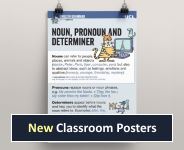Phrases: coordination
In this lesson, students look at phrases conjoined by coordinating conjunctions.
Goals
- Identify different types of phrases which have been conjoined with coordinating conjunctions.
- Consider the effect of conjoining more than one phrase.
- Consider the effect of omitting coordinating conjunctions.
Lesson plan
Click on the interactive whiteboard icon (top right) and work through the following slides with students.
»
- Printer-friendly version
- Log in to view or leave comments


